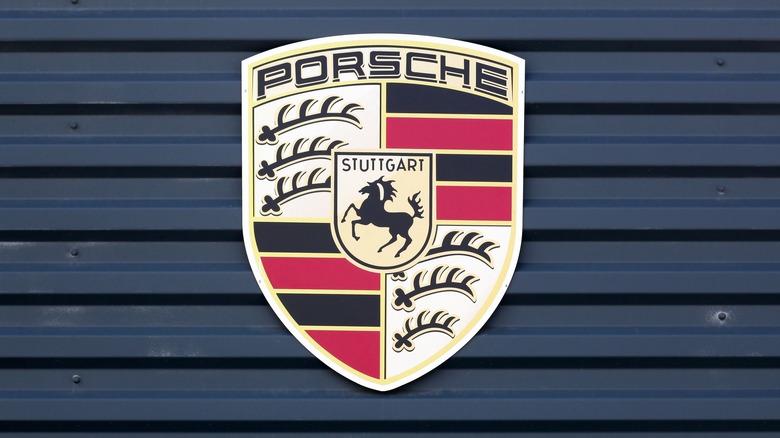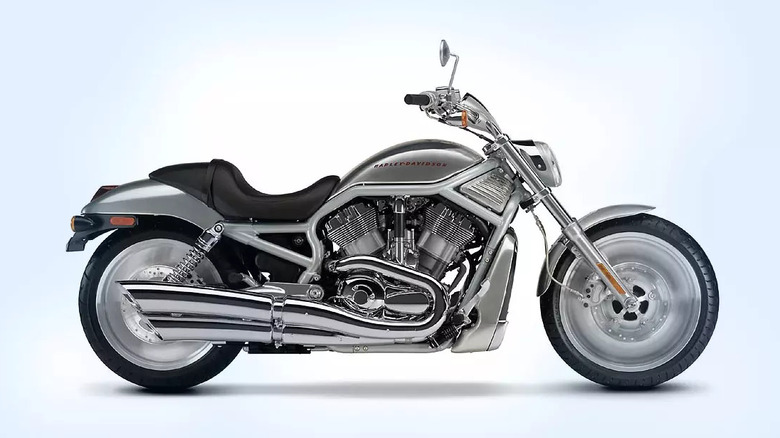How Porsche Helped Harley-Davidson Build The V-Rod's Engine
The names Harley-Davidson and Porsche carry as much weight in automotive circles as any manufacturers in the history of moving vehicles. The iconic brands, of course, hold sway over decidedly different segments of the automotive markets, with Harley-Davidson making its name in the motorcycle game, and Porsche earning renown for producing automobiles.
Given the disparate focus of their manufacturing outputs, Harley-Davidson and Porsche hardly seemed like obvious partners for collaboration. Yet, in the early 2000s, the automotive titans indeed got together to combine their talents in the name of creating Harley's famed V-Rod cruiser. Turns out, the V-Rod was not actually the first time the companies had gone hive-mind for a Harley build, with the motorcycle maker turning to Porsche in the 1970s to help develop the innovative, but ultimately abandoned Nova engine.
Developed in part to woo younger riders enthralled by powerful Japanese and American bikes and attract younger riders, the V-Rod (or VRSC as it was officially named) ran on one of the more unique and powerful engine's in the company's history — one that found Porsche and Harley-Davidson engineers collaborating to transform the latter's VR1000 Superbike racing engine into a street ready, liquid-cooled 120 horsepower monster capable of devouring any blacktop if encountered. Porsche's engineers also equipped the DOHC four-valve V-twin engine with dual overhead cams and fuel injection, making it a true rarity in Harley's legendary lineup of bikes.
The V-Rod was a relatively short-lived revolution for Harley-Davidson
The aptly named Revolution engine was the first water-cooled motor to power a Harley-Davidson, arriving in stark contrast to the air-cooled Evolution engine that essentially saved Harley-Davidson from bankruptcy two decades prior. While the V-Rod was as loud and powerful as anything in the Harley-Davidson lineup, some diehard fans weren't ready to embrace the water-cooled Revolution, with the bike proving one of the manufacturer's more divisive builds when it hit showroom floors in 2002.
Though the V-Rod's power was hard to ignore, some Harley-Davidson purists reportedly wanted little to do with the forward-thinking motorcycle, as some took issue with V-Rod's decidedly modern look (accented by a Fatboy back tire) and its radically re-designed engine. Even as some of Harley-Davidson's long-time fans were choosing to stay away from the souped-up cruiser, the V-Rod was hardly a failure in the manufacturer's lineup. In fact, the Revolution powered bike was apparently quite appealing to the market segment Harley-Davidson designed it for, with the company claiming the V-Rod was indeed attracting a younger, and more diverse consumer base to the brand.
The numbers for Harley's powered by the Porsche-engineered Revolution engine must have been solid enough, as the bike maker continued to produce the divisive build for the better part of a 20-year span. In the end, Harley-Davidson bosses finally pulled the plug on both the V-Rod and the Revolution in 2017. Even as the bike and the engine failed to forever revolutionize the Harley-Davidson lineup, each continues to hold a unique place in the company's storied history.

